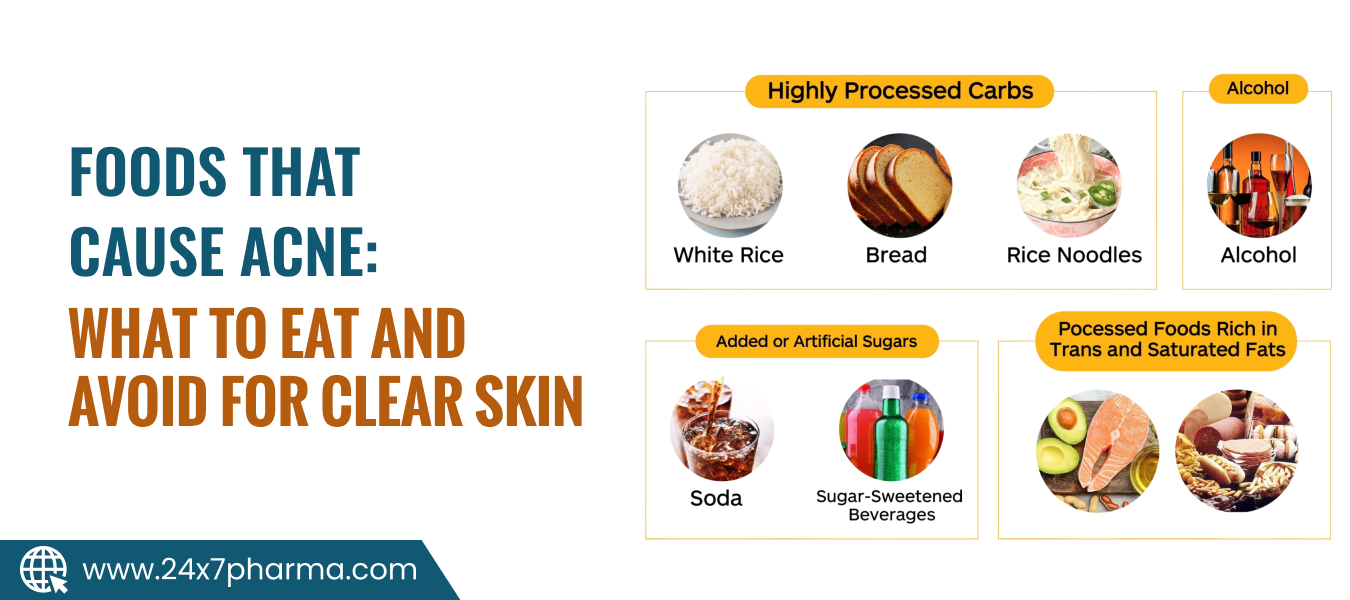Introduction
Acne isn’t just a teenage problem—it affects people of all ages. While hormones, stress, and skincare routines play a role, research increasingly points to diet as a key factor. The connection between what we eat and how our skin reacts is more than skin-deep. If you struggle with acne, adjusting your diet may be a game-changer. In this article, we’ll explore the foods that can trigger breakouts and the ones that help you glow from the inside out.
How Diet Affects Acne
Your skin reflects your internal health. When you eat foods high in sugar or unhealthy fats, your body produces more insulin and inflammatory chemicals, which can stimulate oil glands and clog pores. Over time, these reactions may lead to acne flare-ups.
Scientific studies also suggest that certain foods influence hormones like insulin-like growth factor 1 (IGF-1), which may contribute to increased oil production and inflammation in the skin. That said, everyone’s body is different, and not all dietary triggers affect everyone the same way.
Foods That May Trigger Acne
1. High-Glycemic Foods
Refined carbohydrates like white bread, sugary snacks, and sweetened cereals spike your blood sugar levels quickly. This triggers a surge in insulin, which may increase sebum (oil) production and worsen acne.
Examples to avoid:
- White bread and pasta
- Soda and energy drinks
- Potato chips and pastries
2. Dairy Products
Dairy—especially skim milk—has been linked to acne in some individuals. While milk is nutritious, it may also influence hormone levels, including IGF-1, which can stimulate oil glands.
Tip: If you suspect dairy is a trigger, try eliminating it for a few weeks and track any changes in your skin.
3. Processed and Fast Foods
Fast foods are often loaded with saturated fats, refined carbs, and salt. These ingredients may promote systemic inflammation and hormonal changes that aggravate acne.
Examples:
- French fries
- Burgers
- Fried chicken
- Pre-packaged snacks
4. Whey Protein Supplements
Whey protein, popular among fitness enthusiasts, may increase breakouts, especially on the face, chest, and back. Whey can boost levels of IGF-1, making it a potential acne trigger in some individuals.
Skin-Friendly Foods to Eat Instead
1. Low-Glycemic Foods
Whole foods with a low glycemic index help balance blood sugar and reduce insulin spikes—both of which are beneficial for skin clarity.
Best choices:
- Quinoa, oats, and brown rice
- Lentils and beans
- Leafy greens and non-starchy vegetables
2. Omega-3 Fatty Acids
Omega-3s help fight inflammation and support overall skin health. Regular consumption may reduce the severity and frequency of breakouts.
Great sources:
- Fatty fish (salmon, sardines)
- Flaxseeds and chia seeds
- Walnuts
3. Antioxidant-Rich Fruits and Vegetables
Antioxidants help combat oxidative stress and protect your skin’s barrier. They also assist in repairing damaged skin cells and reducing redness.
Top picks:
- Berries (blueberries, strawberries)
- Carrots and sweet potatoes (rich in beta-carotene)
- Spinach, kale, and broccoli
4. Probiotics and Fermented Foods
A healthy gut equals healthier skin. Probiotics support gut microbiota, which may reduce inflammation and support a clearer complexion.
Skin-friendly options:
- Yogurt with live cultures
- Kefir
- Sauerkraut and kimchi
Read More : The Ultimate Acne Guide: Causes, Treatments & Prevention
Tips to Manage Diet-Related Acne
- Keep a food diary: Track your meals and skin reactions to identify personal triggers.
- Make slow changes: Gradually reduce acne-triggering foods instead of cutting them out all at once.
- Stay hydrated: Water helps flush out toxins and supports skin hydration.
- Consult a professional: A dermatologist or nutritionist can provide personalized advice based on your skin and dietary needs.
Debunking Common Myths About Food and Acne
Many believe chocolate causes acne. However, it’s not the cocoa but the sugar and dairy in milk chocolate that may be the culprit. In fact, dark chocolate (70% and above) contains antioxidants and is less likely to trigger breakouts.
Another myth is that greasy foods like pizza always cause acne. The link lies more with refined carbs and inflammation than with dietary fat alone.
Conclusion
While no single food causes acne in everyone, certain dietary patterns can increase the likelihood of breakouts. By reducing high-glycemic foods, dairy, and processed items—and adding more whole, anti-inflammatory options—you may notice clearer skin over time. Diet isn’t a cure-all, but it’s a powerful tool in your skincare journey.
Clear skin starts from within—one mindful bite at a time.

